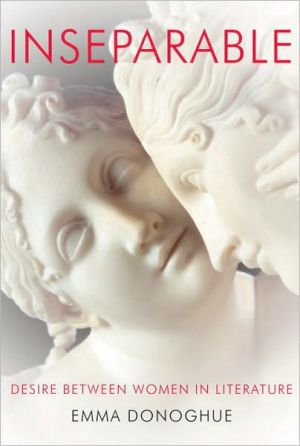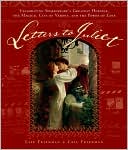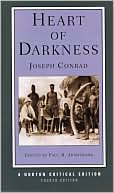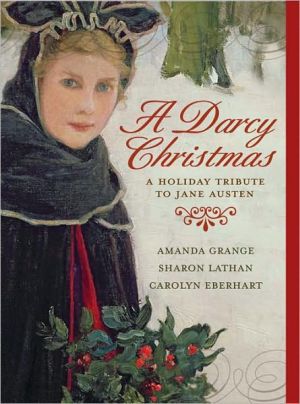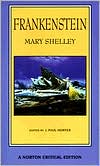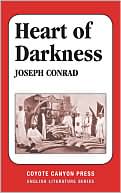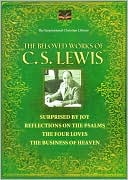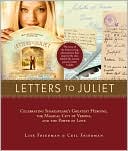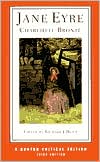Inseparable: Desire Between Women in Literature
Emma Donoghue, consummate scholar and novelist of astonishing originality, examines how desire between women in literature has been portrayed—from schoolgirls and vampires to runaway wives, from cross-dressing knights to contemporary murderesses. Donoghue excavates the long-obscured tradition of friendship between women, one that is surprisingly central to our cultural history. From Chaucer and Shakespeare, Sade, Balzac, Thomas Hardy and Radclyffe Hall to Agatha Christie, Patricia Highsmith...
Search in google:
From a writer of astonishing versatility and erudition, the much-admired literary critic, novelist, short-story writer, and scholar (“Dazzling”—The Washington Post; “One of those rare writers who seems to be able to work on any register, any time, any atmosphere, and make it her own” —The Observer), a book that explores the little-known literary tradition of love between women in Western literature, from Chaucer and Shakespeare to Charlotte Brontë, Dickens, Agatha Christie, and many more. Emma Donoghue brings to bear all her knowledge and grasp to examine how desire between women in English literature has been portrayed, from schoolgirls and vampires to runaway wives, from cross-dressing knights to contemporary murder stories. Donoghue looks at the work of those writers who have addressed the “unspeakable subject,” examining whether such desire between women is freakish or omnipresent, holy or evil, heartwarming or ridiculous as she excavates a long-obscured tradition of (inseparable) friendship between women, one that is surprisingly central to our cultural history.Donoghue writes about the half-dozen contrasting girl-girl plots that have been told and retold over the centuries, metamorphosing from generation to generation. What interests the author are the twists and turns of the plots themselves and how these stories have changed—or haven’t—over the centuries, rather than how they reflect their time and society. Donoghue explores the writing of Sade, Diderot, Balzac, Thomas Hardy, H. Rider Haggard, Elizabeth Bowen, and others and the ways in which the woman who desires women has been cast as not quite human, as ghost or vampire.She writes about the ever-present triangle, found in novels and plays from the last three centuries, in which a woman and man compete for the heroine’s love . . . about how—and why—same-sex attraction is surprisingly ubiquitous in crime fiction, from the work of Wilkie Collins and Dorothy L. Sayers to P. D. James.Finally, Donoghue looks at the plotline that has dominated writings about desire between women since the late nineteenth century: how a woman’s life is turned upside down by the realization that she desires another woman, whether she comes to terms with this discovery privately, “comes out of the closet,” or is publicly “outed.”She shows how this narrative pattern has remained popular and how it has taken many forms, in the works of George Moore, Radclyffe Hall, Patricia Highsmith, and Rita Mae Brown, from case-history-style stories and dramas, in and out of the courtroom, to schoolgirl love stories and rebellious picaresques. A revelation of a centuries-old literary tradition—brilliant, amusing, and until now, deliberately overlooked.The New York Times - Kathryn HarrisonDonoghue's adroit commentary, along with her chronologically organized bibliography, makes Inseparable necessary for scholars and enlightening and often amusing for anyone else. As an introduction to literature most of us would never find for ourselves, it corrects the cultural myopia that has limited the average reader's knowledge of lesbian fiction to Rita Mae Brown's Rubyfruit Jungle and Radclyffe Hall's Well of Loneliness…
Introduction\ When i was a small child I read fairy tales. I carried straining plastic bags of them home from the library every Saturday: Grimm, Perrault, Hans Christian Andersen, Arabian Nights, Br’er Rabbit, Celtic myths, Polish folktales, Italian ones, Japanese, Greek . . . Soon I started spotting repetitions. It thrilled me to detect the same basic shape (for instance, the motif of the selkie, or wife from the sea) under many different, exotic costumes. When I announced my discovery to my father, he broke it to me gently that others had got there first: a Russian called Vladimir Propp, and before him a Finn called Antti Aarne, who published his system of classifying folk motifs back in 1910. Ah well. This disappointment taught me, even more than the fairy tales had, that there is nothing new under the sun.\ I remained a greedy reader, and when I found myself falling for a girl, at fourteen, I began seeking out stories of desire between women. The first such title I spent my hoarded pocket money on was a truly grim Dutch novel first published in 1975, Harry Mulisch’s Twee Vrouwen (in English, Two Women). Sylvia leaves Laura for Laura’s ex-husband, Alfred—but, it turns out, only to get pregnant. The two women are blissfully reunited for a single evening of planning the nursery decor before Alfred turns up and shoots Sylvia dead, leaving Laura to jump out a window. Shaken but not dissuaded, I read on, for the next twenty years and counting. You would be forgiven for thinking that my book list must have been rather short. But the paradox is that writers in English and other Western languages have been speaking about this so-called unspeakable subject for the best part of a millennium.\ What I am offering now in Inseparable is a sort of map. It charts a territory of literature that, like all undiscovered countries, has been there all along. This territory is made up of a bewildering variety of landscapes, but I will be following half a dozen distinct paths through it. Despite a suggestion in the New York Times in 1941 that the subject of desire between women should be classified as “a minor subsidiary of tragedy,” in fact it turns up across the whole range of genres. Reading my way from medieval romance to Restoration comedy to the modern novel, mostly in English (but often in French, and sometimes in translations from Latin, Italian, Spanish, or German), I uncover the most perennially popular plot motifs of attraction between women. Here they are, in a nutshell.\ TRAVESTIES: Cross- dressing (whether by a woman or a man) causes the “accident” of same- sex desire.\ INSEPARABLES: Two passionate friends defy the forces trying to part them.\ RIVALS: A man and a woman compete for a woman’s heart.\ MONSTERS: A wicked woman tries to seduce and destroy an innocent one.\ DETECTION: The discovery of a crime turns out to be the discovery of same- sex desire.\ OUT: A woman’s life is changed by the realization that she loves her own sex.\ At this point you may wonder, are the women in these plays, poems, and fictions lesbians? Not necessarily, is how I would begin to answer. But perhaps we are better off postponing that question until we have asked more interesting ones. In the first five of my six chapters, I will be looking at relations between women, rather than the more historically recent issue of self-conscious sexual orientation. Although I occasionally say lesbian as shorthand, the twenty-first-century use of that word as a handy identity label does not begin to do justice to the variety of women’s bonds in literature from the 1100s to the 2000s. The past is a wild party; check your preconceptions at the door.\ It is customary to lament the fact that desire between women, before the twentieth century, was one long silence. After all, everyone has heard the story about Queen Victoria, whose ministers wanted to make lesbian sex illegal in 1885 but could not bring themselves to explain to her that it was even possible . . . Except that it turns out that never happened. (Dating from 1977, the Victoria story is a popular urban myth that allows us to feel more knowledgeable and daring than our nineteenth-century ancestors.) On the contrary, literary researchers over the past few decades have unearthed a very long history of what Terry Castle calls “the lesbian idea”; her eleven- hundred-page anthology The Literature of Lesbianism (2003)—by far the best available—can only sample the riches.\ In writing Inseparable, I have had to be very selective. A hint or a glimpse does not constitute a plot motif: I include only texts in which the attraction between women is undeniably there. It must also be more than a moment; it must have consequences for the story. The emotion can range from playful flirtation to serious heartbreak, from the exaltedly platonic to the sadistically lewd, but in every case it has to make things happen.\ Take, for instance, “The Man of Law’s Tale,” the fifth of the Canterbury Tales (1400) by courtier and diplomat Geoffrey Chaucer. It tells how Custance, daughter of a Christian Roman emperor and bride of the sultan of Syria, is cast adrift in a boat through her mother-in-law’s machinations. Shipwrecked on the Northumberland coast, Custance immediately arouses the protective passion of Dame Hermengyld, the constable’s wife: “Hermengyld loved hire as hir lyf.” Over months of prayers and tears, Custance wins Hermengyld from paganism to Christianity, and Hermengyld manages to cure a blind man in the name of Jesus—which prompts her husband to convert too. But a knight whom Custance has rejected is jealous of the women’s closeness; he sneaks into the room where they are sleeping together and slits Hermengyld’s throat, leaving the bloody knife beside Custance to frame her for murder. The people are not fooled by this circumstantial evidence, since they have witnessed the women’s relationship with their own eyes: “For they han seyn hir evere so vertuous, / And lovyng Hermengyld right as hir lyf.” (For they have seen Custance be virtuous all the time, and love Hermengyld as her life.) The people’s suspicion is confirmed by divine intervention: as the knight tells his lies in court, his eyeballs suddenly drop out of his head. This is an excellent example, perhaps the earliest in English, of how a mutual passion between two women can be not just an ornamental extra, but what moves the story along.\ . . .\ Because of the time frame I have chosen, most of the texts discussed in Inseparable are by British or French men. For the purposes of this book, I do not much care who wrote them, nor why. What interests me is the stories themselves, and the ways they connect. Though love between women can be found in some medieval romances, it was in the sixteenth century that it really moved into the spotlight, and from that point on it has taken up more and more space, growing from a mere theme into a literary tradition of its own.\ But as traditions go, it is a peculiar one. One reason is that—if I may state the obvious—lesbian storylines begin with two or more\ women, rather than a man and a woman. This means that gender roles are up for grabs. Those who write about love between the sexes, from the book of Genesis on, have relied on a certain consensus about the differences between husband and wife, say, or lover and mistress, or rake and ingénue. Even if they bend those hallowed cultural rules, they are playing a familiar game. And those who write about love between men—although the subject is fraught with danger—have the classical past to draw on, and especially the Platonic ideal of the older male lover/mentor and the beautiful young beloved/protégé. Those who write about love between women have no such agreed starting point.\ Here, for instance, is the moment in Mary McCarthy’s The Group (1963) when Lakey’s old college friends fret over the fact that she has come home with a female lover.\ On the one hand, there were Lakey- and- Maria, as you might say Polly-and-Jim, a contented married pair; on the other, there was an exquisite captive of a fierce robber woman, locked up in a Castle Perilous, and woe to the knight who came to release her from the enchantment. But it was possible to see it the other way around. Supposing it were Lakey, the inscrutable, intelligent Lakey, who had made poor Maria, who was not very bright, her slave? The fact that it was possible to reverse the relation like an hourglass was what the girls found so troubling.\ If this easily flipped “hourglass” was still a puzzle in the 1960s, how much more so in the 1100s. Perhaps this is one reason the theme has aroused the interest of so many writers, who, like Lakey’s friends, find the notion of desire between women a lasting source of wonder and fantasy, as well as anxiety.\ Another oddity of this literary tradition is that it includes as much denial or coyness as assertion. I picture this literature as an archipelago: thousands of stories, but scattered like islands in little pools of silence. Interestingly, you might expect that the earlier texts would be veiled, and the later ones explicit—but I have found that erotic situations between women are sometimes presented frankly in medieval or Renaissance romance, whereas well into the twentieth century many novelists evoke passion with the discreet vocabulary of friendship.\ Passion between women has never had a settled status in Western culture, or even a definition with fixed parameters. Right through the hymns of praise to noble love between ladies crash discordant rants against lust between wicked females. In every generation, it seems, writers have asked themselves whether desire between women is unprecedented or omnipresent, holy or evil, heartwarming or ridiculous. No matter how often it is written about, it remains somehow unofficial, lurking below the radar: an unsolvable puzzle, a perpetual novelty. Unlike say, flowers, or food, or the weather, this subject could be extremely tricky for writers. Queen Victoria—myths aside—probably knew more or less what could go on between women, but that does not mean that the subject was a safe one in her time, or before, or after. In 1921, twenty years after her death, the House of Lords did defeat an attempt to add lesbianism to the law against male homosexuality; the peers feared to “advertise” this vice by naming it. Quite a few of the books and plays I discuss in Inseparable were censored, suppressed, or prosecuted in their day. And even if there were no legal consequences for writers who tackled this subject, there was always the risk of mystifying or outraging part of their audience.\ So what did they do, these men (and eventually women) of the scribbling tribe, who were troubled or intrigued by the idea of passion between women, but unsure how to shape it into a story, and wary of how people might take it? They looked over their shoulders. They relied heavily on their reading (either of their contemporaries or of ancient sources), whether by copying without scruple, self-consciously echoing a name or a speech from a previous work, borrowing aspects of several different storylines to make something new, confirming or countering or defying previous literary models.\ Being a novelist and playwright by trade, I say this by experience as much as observation: writers like old plots because they work, and for all our claims of originality, we do a lot of recycling. If all writing is intertextual, writing about desire between women—because of its controversial status—has been particularly so.\ So Inseparable could also be called a family tree, because it lays out certain motifs that have been repeated over the centuries, hybridizing and mutating in every generation. Or you could think of it as a field guide to the flora and fauna of lesbian-themed literature. It calls attention to what is there, but generally goes unnoticed, and reveals how the rare is related to the common-or-garden variety.\ Which begs the question, if literature has been full of the theme of women in love for so many centuries, then why has it so often gone unnoticed? Why is desire between women still generally presumed to be a late-twentieth-century theme?\ Some of the texts I look at here have been forgotten because they did not reach many readers in the first place, or because, although popular in their day, they have long since dropped out of circulation. But given that this tradition includes such canonical authors as Chaucer, Shakespeare, Sidney, Richardson, Rousseau, Johnson, Diderot, Dickens, Balzac, Charlotte Brontë, Wilkie Collins, Maupassant, Hardy, James, and Lawrence—given that, as Terry Castle puts it, “virtually every author of note since the Renaissance has written something, some where, touching on the subject of love between women”—how can we have collectively forgotten it, let it slip out of the history of ideas, or not registered it in the first place?\ Writers must bear some of the responsibility. Very often they break a same- sex story up and scatter the pieces across a longer narrative, or limit the story to the subplot where it will attract less attention. Judith Roof argues, of Sigmund Freud’s “Three Essays on the Theory of Sexuality” (1905), that\ Freud envisions both story and sexuality as a single strong stream gushing gleefully into the wide sea of human generation. This oceanic finale exalts both healthy heterosexuality and the satisfying story. Any impediments to an unobstructed flow force the current away from its appointed end into tiny, doomed side-streams, their deviance spawning a degenerate or perverted story.\ There is a certain logic, then, to the fact that many of the most interesting stories of desire between women lurk in the “side- streams” of novels and plays, not the main orgasmic “flow” of the narrative. Also, novelists and playwrights often seem to have suffered from a failure of nerve—beginning a story of passion between women and then veiling or disavowing it, breaking it off, or hastily bringing on a man to erase the significance of what is happening between the women. TomasHardy in Desperate Remedies (1871) offers what may be a sly commentary on his novel’s evasive presentation of an older woman’s attempt to seduce her maid:\ It was perceived by the servants of the House that some secret bond of connection existed between Miss Aldclyffe and her companion. But they were woman and woman, not woman and man, the facts were ethereal and refined, and so they could not be worked up into a taking story.
TABLE OF CONTENTSLIST OF ILLUSTRATIONS INTRODUCTION TRAVESTIES The Female Bridegroom · The Male AmazonINSEPARABLES Shall We Be Sunder’d? · JealousiesRIVALS Rakes vs. Ladies · Feminists vs. Husbands · The Beautiful HouseMONSTERS Sex Fiends · Secret Enemies · Not Quite HumanDETECTIONNow You See It · Crimes of Passion · It Takes One to Know OneOUTCase Histories · On Trial · First Love · Devil May Care · Places for UsACKNOWLEDGMENTS NOTESSELECT BIBLIOGRAPHY SUGGESTIONS FOR FURTHER READINGINDEX
\ Kathryn HarrisonDonoghue's adroit commentary, along with her chronologically organized bibliography, makes Inseparable necessary for scholars and enlightening and often amusing for anyone else. As an introduction to literature most of us would never find for ourselves, it corrects the cultural myopia that has limited the average reader's knowledge of lesbian fiction to Rita Mae Brown's Rubyfruit Jungle and Radclyffe Hall's Well of Loneliness…\ —The New York Times\ \ \ \ \ Publishers Weekly“The past is a wild party; check your preconceptions at the door,” warns British literary historian and novelist Donoghue (Slammerkin) in her comprehensive catalogue of a thousand years of Western literature. “[I]n Western culture passion between women is always a big deal, whether presented as glorious or shameful, angelic or monstrous,” she claims. These passions are not always, strictly speaking, lesbian, Donoghue says, as she sorts them into categories (e.g., cross-dressing and the resulting “ 'accident' of same-sex desire' ”; women friends who remain inseparable despite all obstacles). She links them to historical developments and deciphers their sometimes obscure language. “Morbid,” for example, was often a code word for “lesbian” in the 19th century. Delivering on her promise of a wild party, Donoghue reads Clarissa as a rivalry between Lovelace and Anna for Clarissa's heart; she considers Jane Eyre as an early schoolgirl novel (note Jane's crush on her schoolmate Helen), whose form would be adapted by early lesbian coming-out novels. With her excellent reading list, readers can test for themselves the “unexpected continuity” Donoghue finds in the presence of passion between women in Western literature. 19 photos. (May 26)\ \ \ Library JournalDonoghue (Slammerkin), a prolific writer of fiction and literary history, spent over 12 years on this indispensable work, examining desire between women characters found mainly in English, French, and other Western literary works that span the Middle Ages to modern times. She analyzes numerous titles as diverse as Shakespeare's As You Like It, Diderot's La Religieuse, Dickens's Little Dorrit, and 20th-century pulp fiction. She divides her analysis into six chapters inspired by the popular plot motifs created when representing attraction between women: "travesties," "inseparables," "rivals," "monsters," "detection," and "out." The literature discussed here portrays female-female desire but with great variation. The chapter on monsters, for example, demonstrates how negatively this type of desire was often depicted, while the "coming out" chapter highlights how this depiction has changed in the past 40 years. Donoghue also acknowledges the few works that anticipated societal transformations and tolerance decades before they occurred. VERDICT For all readers interested in this subject and GLBT, women's studies, and Western literature scholars.—Erica Swenson Danowitz, Delaware Cty. Community Coll., Media, PA\ \
